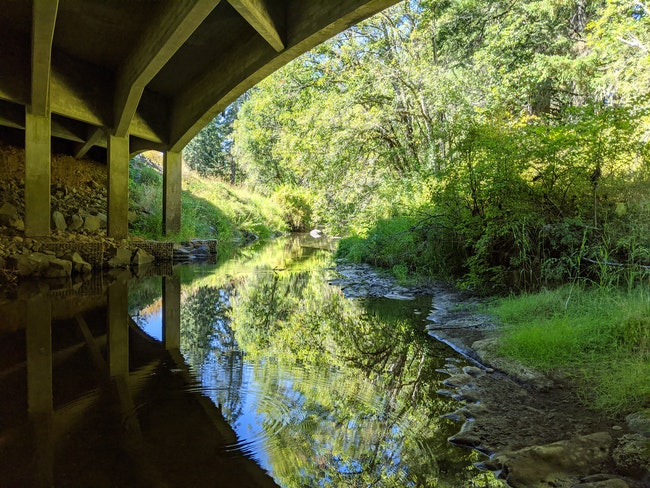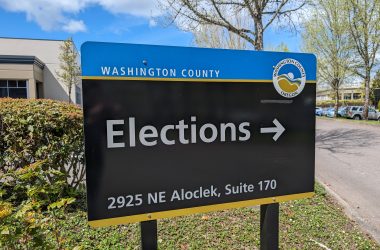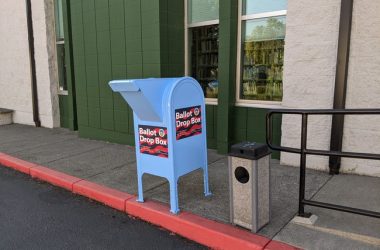 Despite their name, the Tualatin Soil and Water Conservation District also includes portions of the Nehalem River watershed, such as this stretch running under Highway 26 near Timber. Photo: Chas Hundley
Despite their name, the Tualatin Soil and Water Conservation District also includes portions of the Nehalem River watershed, such as this stretch running under Highway 26 near Timber. Photo: Chas Hundley
The 2020 election season is like no other in recent memory, or arguably in living memory, at all levels of contest — federal, state, and local.
This election season is ripe with intriguing contests for contested seats in the Oregon House of Representatives in both districts 31 and 32, which extend throughout our news coverage area, as well as in county commission contests and city council elections in all corners of Oregon from the high desert in the east, to the cities and towns dotting the Willamette Valley, to the coastal towns on the edge of the often-stormy sea.
There also are many publicly-elected positions on the ballot that the average voter doesn’t pay close attention to, if at all, because they are elections for bodies, boards, commissions, or individual positions that do not receive the type of attention they deserve in Oregon’s 2020 news media.
Take for example the Tualatin Soil and Water Conservation District (TSWCD). It has five positions up for election this year, yet much of the voting public is not only unaware of who the candidates are, many Washington County residents simply don’t know that the board exists at all, what it does, or why it even matters.
What is the Tualatin Soil and Water Conservation District?
The TSWCD is a publicly-elected board consisting of Washington County officials charged with identifying natural resource challenges and using time-tested and cutting-edge methods of research and determinations to achieve solutions.
The board’s official mission is “working collaboratively to establish programs, develop strategies, and set priorities to ensure the conservation district works effectively toward its mission of protecting natural resources and creating a healthy, productive Washington County community,” the TSWCD website asserts.
The conservation district map has five geographic zones, each with one representative, as well as two at-large positions that cover the entire district. For the 2020 election cycle, residents of the city of Banks and each of the communities of the surrounding body politic should know that both at-large positions are critical positions voters in our region should intimately consider.
The Tualatin Soil and Water Conservation Zone 2 map encompasses everything south of Highway 6 from the Tillamook county line to the junction of highways 6 and 8. From there, the district’s map includes everything south of Highway 8, a.k.a. Gales Creek Road, into the Forest Grove City Limits and everything west of Highway 47 and portions of Old Highway 47 down to Gaston.
 Help us increase our 2020 election coverage with a digital subscription, featuring a $10 discount now through November 3 for an annual subscription. Monthly plans are $8/month. Click here to start
Help us increase our 2020 election coverage with a digital subscription, featuring a $10 discount now through November 3 for an annual subscription. Monthly plans are $8/month. Click here to start
Who are the candidates?
Running again for the four-year Zone 2 position is incumbent Eldon Jossi, a Gales Creek resident and manager of the 1,100-acre Gales Creek Farm, which he said primarily imports alfalfa and orchard grass from eastern Oregon to sell locally and regionally.
Jossi won the 2016 election unopposed with 98.45 percent of the vote. Write-ins — the Oregon Secretary of State’s office does not list the names of people who were written in as candidates — accounted for the remaining 1.55 percent of votes.
Steve Vangrunsven, a Verboort resident and the incumbent for At-Large Position #1 and interim chairman of the board, also is running unopposed for re-election.
Vangrunsven earned a bachelor of science degree from Oregon State University in crop soil science, although he actually attended college at Eastern Oregon University where OSU operates a satellite program, he said.
Vangrunsven lists his occupation as an agronomist — an expert in the science of soil management and crop production. He said he works for Nampa, Idaho-based Valley Agronomics, a company with locations in Idaho, Washington, Oregon, and Utah, including seven subsidiaries in northwestern Oregon, that provides crop growers with information and techniques to better maximize their yields.
Vangrunsven also listed additional occupations as a farm laborer, an agriculture center consultant, a CDL driver, and a fertilizer application technician.
“I wear many hats,” he said. “My day job is working with farmers producing crops with genetics, fertilizers, crop protection, soil nutrition … things like that, from seed to harvest. We also have a 40-acre family farm that was my dad’s place and my grandfather’s farm before that. Then, I married into a dairy farm – Marsh Homestead – that is now, with my daughter on board, in its seventh generation of family operations going all the way back to 1856.”
Vangrunsven said he thinks the real story in this year’s election is the three people running to fill the second at-large position. That board seat was held by John McDonald, who resigned this past summer according to the board’s minutes dated August 11. McDonald will continue working as a director emeritus with the TSWCD board until the newly-elected candidate is sworn in this coming January.
The same day McDonald’s resignation became official the board elected, without a single nay vote cast, to allow Hillsboro resident Kieran Sikdar to fill McDonald’s vacant seat until voters choose who will fill the At-Large #2 position.
Sikdar lists his occupation in his declaration of candidacy as a director of green infrastructure for West Consultants, Inc., which has operations in seven U.S. states. He also lists additional work experience as a ranch/farmhand, a green infrastructure specialist, and a stormwater solutions director, all occurring in Tucson, Ariz. Additionally, Sikdar’s LinkedIn webpage says he earned a master’s degree from Ohio State University in civil engineering and integrated systems engineering.
Sikdar, who technically is the incumbent, is facing two opponents for the At-Large #2 position — Dean Moberg, who lists his home address in Washington County’s 97229 zip code, which includes the unincorporated communities of Cedar Mill, Rock Creek, and Bethany, among others; and Casey Storey, a resident of Forest Grove who graduated from Marylhurst University with a master’s of business administration in sustainable business practices, and a second master’s degree in conservation ecology and sustainable development from the University of Georgia at Athens.
Moberg’s declaration of candidacy lists his occupation as a retired conservation planner for the U.S. Department of Agriculture’s Natural Resources Conservation Service from 1985-2020. Prior to that position, Moberg worked from 1981-1984 as an agriculture teacher in Medina, New York, and as a farmhand in California, Illinois, and New York from 1974-1981.
Moberg has a Ph.D. in environmental science and engineering from Oregon Health and Science University, and a master’s of arts in teaching from Cornell University.
Storey lists his occupation as an environmental consultant with Portland-based design engineering firm David Evans and Associates, Inc. He also said his previous employment included working as a staff scientist and permit specialist with WHPacific in Washington County, as a field scientist with Atlanta-based CH2M Hill Companies (incidentally founded in Corvallis in 1946), and as a research coordinator and graduate assistant within the University of Georgia’s Department of Ecolog in Athens.
Storey, Moberg, and Sikdar were not available for comment as of press time.
In related news
StreetRoots.org, a weekly alternative newspaper published in Portland and sold by people experiencing homelessness as a means of income, published a story on September 15 reporting that “Oregonians may continue to fight for the environment, but the days of (Tom) McCall Republicans are over” and that the “political climate in Oregon may threaten the natural climate.”
The story says Meredith Connolly, director of the Portland-based nonprofit Climate Solutions, said McCall’s legacy “could become a case of paradise lost.”
McCall led Oregon during his time as governor from 1967 to 1975 through many, many conservation efforts — from creating the returnable bottle and beach bills and curbside recycling to cleaning up the Willamette River and other waterways, as well as the creation of the Department of Land Conservation and Development.
The article reports that Connolly said she sees McCall’s legacy being abandoned with little hope for bipartisanship, citing evidence as the hundreds and hundreds of Oregonians who coalesced at the capitol steps in Salem to protest the wearing of masks during early days last spring of the COVID-19 pandemic.
The TSWCD is a legislative assembly, yes, but one that is required by state law to be nonpartisan, and one that frequently reports back to the public, and to politicians, its findings about what’s happening to our environment here in northwest Oregon.
The board annually reports on the state of water quantity and quality, the health of soil, fish and wildlife habitats, invasive species, the health of forests, farmland protection, air quality, its programs and strategies, including habitat, urban, rural and forest conservation, known challenges and opportunities, and gaps and needs as well as known limitations and constraints.
With the state government deadlocked in disagreements that seemingly have no end, the Tualatin Soil and Water Conservation District is an important electoral board in Washington County.
Additional information
Currently, the TSWCD is funded by state and federal grants, both private and public, and Measure 34-269, a 2016 property tax levy that passed with 59 percent of voters in favor of paying about 9 cents per $1,000 of assessed home values, or about $22 per month for a home valued at $240,000.
But there are not many homes in Washington County valued at $240,000 anymore. In fact, Zillow.com, an online real estate database that says it accurately lists the prices of 110 million U.S. homes, lists the median value of a single-family home in Washington County at $444,066, meaning that TSWCD levy is more like $40 a month for each homeowner, not $22.
Election and eligibility information for the TSWCD is available to read online at the board’s website – swcd.net.
Agendas and minutes from previous Tualatin Soil and Water Conservation District meetings are available here on the district’s website.
To read TSWCD reports and publications, including annual reports going back to 2008-2009, and the district’s long-range business plans, visit the reports and publications page on its website.
A detailed directory with information about all of Oregon’s soil and water conservation districts is available online at the state Department of Agriculture website.
A 10-minute mini documentary, posted on YouTube by the National Association of Conservation Districts, titled “Past, Present and Future of Conservation Districts,” details the inception of America’s conservation districts following the Dust Bowl years of the 1930s up through modern times.
Also, in 1962, McCall, who worked as a journalist before going into politics, created a one-hour documentary called “Pollution in Paradise” that aired on KGW-TV on Nov. 21 that year. That documentary is available on YouTube and can be viewed by clicking here.
This story originally referred to Storey with an incorrect pronoun; we regret the error.






